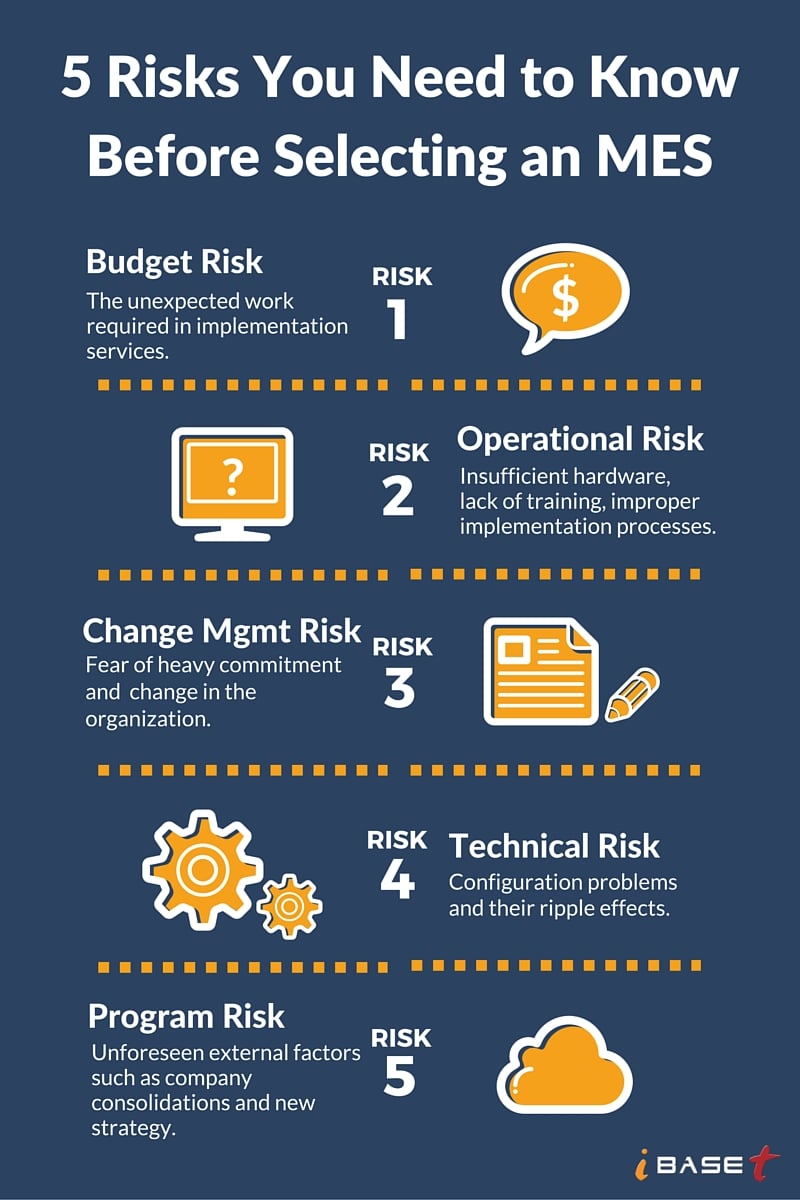

- A custom-built MES configuration based on an MES tool kit
- A Commercial-Off-The-Shelf (COTS) configuration of MES software
These two flavors of MES implementations come with different variations of risk.
Taking the time to do proper risk management, identifying and mitigating risks, can protect the organization from unnecessary costs and heartache. Below you will find key manufacturing risk factors that you must understand in both approaches to ensure a smooth path to implementation.
1. BUDGET RISK
With companies operating with tighter budgets, it is becoming more critical to manage costs throughout the entire implementation, not just the cost of the software licenses. Buying a software can be an expensive proposition if you underestimate the actual work required in services to make the software operational.
Custom built MES configurations based on MES tool kits can run high ratios of license-to-service dollars, often times upwards of 1:5. That means for every $10,000 spent on licenses, you may actually be spending $50,000 in services. With a COTS MES solution, the ratio can drop dramatically to the range of 1:2. It is important that the comparison of various solutions includes both expected license and service costs to get a more accurate pricing estimate. And don’t forget to account for the additional cost of managing the software production lifecycle for the custom solution as the toolkit and platforms require more upgrades.
2. OPERATIONAL RISK
Configured and COTS MES solutions always have some kind of failure risk. The reasons could be inherent, including insufficient hardware, lack of training, and/or other improper implementation processes. Validation is an extremely important exercise when custom building a solution to know how your company’s data and process flows will react in the software system. The one major benefit of looking at a COTS MES solution is that you can conduct a small project up front to test and validate data in a sandbox or emulated environment before making a bigger purchasing decision to rollout. Testing with a small sample of your data and processes in your own environment is one way to mitigate your operational risk.
3. CHANGE MANAGEMENT RISK
Old processes and habits are often hard to change. Changing an organization to move from legacy processes to new ones or to invest in a new software adoption requires heavy commitment from the management and the entire team company wide. Implementing new solutions can be a scary undertaking for anybody and can create fear of change in the organization. Implementing change management procedures combined with executive sponsorship and ample product training are the keys to providing an entire organization the confidence it needs to change.
4. TECHNICAL RISK
Technical risks can cause a sacrifice in performance or a delay in schedule requirements during an MES implementation. A common cause is over configuration and scope creep during an implementation. Continuously adding and changing requirements for an implementation can cause adverse effects on relationships between the configurations in different areas of related functionality. Each change made could have a negative ripple effect and consequences. With tailored solutions, these risks can be higher because configuration is at the crux of the solution and without following or operating to a set of standards, there is more room for failure. COTS MES configurations have the advantage of foreseeing and avoiding certain risks by various testing done by the solution provider and also reviews from multiple user communities.
5. PROGRAM RISK
Every MES implementation project has some degree of program risk where unforeseen external factors can work against a successful implementation. A company could run out of funds, a division could be consolidated and moved or the company changes direction with a new strategy. These are very hard to anticipate and can often be frustrating. That is why it is best to look for solutions that have referenceable and successful implementations done in a reasonable time frame. The longer the time it takes to “go live,” the more room there is for an unforeseen circumstance to come up. Getting implemented in 4 months versus 2 years could be the difference between a successful transformation of your manufacturing environment and a project with unfinished implementation that yielded minor improvements. Only bite off as much as you can chew in a reasonable time frame, even if it means giving up a few things to achieve that first project milestone successfully.


At the end of the day, your company must carefully evaluate the pros and cons for both types of implementations in order to make an informed decision. To get started, download our free eBook, “What is MES?” and gain a better understanding of what Manufacturing Execution Systems can do in complex discrete manufacturing.




